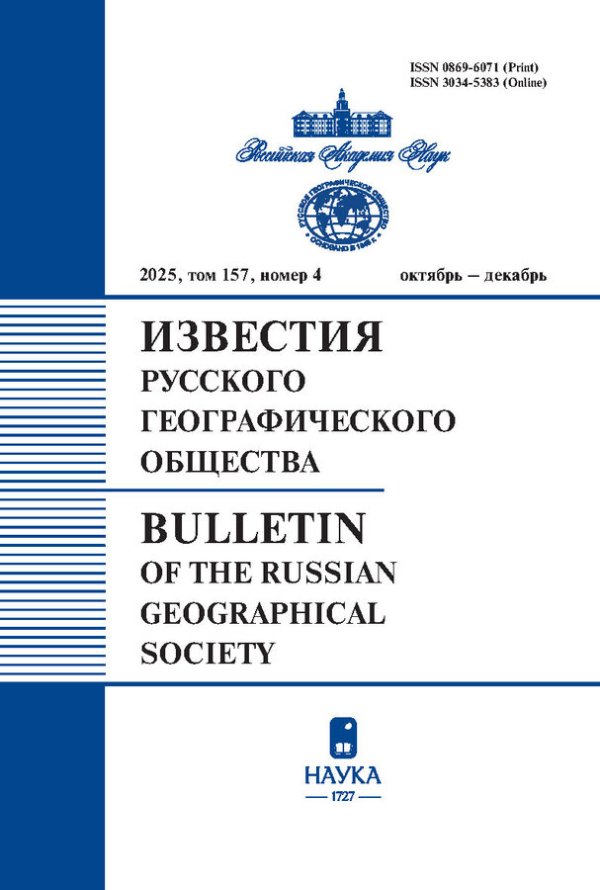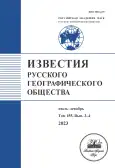Региональная динамика промышленности, сельского хозяйства и населения в России в 1990–2020 гг.: геоэкологическая интерпретация
- Авторы: Клюев Н.Н.1
-
Учреждения:
- Институт географии РАН
- Выпуск: Том 155, № 3-4 (2023)
- Страницы: 74-88
- Раздел: Статьи
- URL: https://journals.rcsi.science/0869-6071/article/view/254227
- DOI: https://doi.org/10.31857/S0869607123030084
- EDN: https://elibrary.ru/YKXIFR
- ID: 254227
Цитировать
Полный текст
Аннотация
Проведена группировка регионов России по типу сопряженной динамики промышленности, сельского хозяйства и населения за 1990–2020 годы, косвенно отражающей и динамику интегральной антропогенной нагрузки на природу. Выявлены зоны, наиболее сильно пораженные трансформационной депрессией, которые охватывают практические все европейское Нечерноземье, юг Восточной Сибири и Дальний Восток. А значительный прирост нагрузок отмечается на Северном Кавказе, в российской Прибалтике, субширотном ареале регионов, протянувшемся от Брянской области до Башкортостана, а также Тюменской области. Усиление нагрузки произошло прежде всего в пределах степной и лесостепной зон, в наибольшей степени трансформированных антропогенной деятельностью. В целом “давление” на природу увеличивается на хорошо освоенной территории (примерно 1/10 часть территории страны, где проживает около трети населения), а сокращается – на обширной слабоосвоенной территории (около половины территории и 1/6 населения России). Новый экологически неблагоприятный тренд в динамике нагрузок на природу – их относительный сдвиг в приморские регионы, на уязвимые к воздействиям и дефицитные в стране рекреационно привлекательные побережья атлантических морей, а также Каспийского моря. Установлено, что ухудшение экологической обстановки в регионах сильного роста нагрузок более вероятно, чем ее улучшение в регионах-лидерах их спада.
Об авторах
Н. Н. Клюев
Институт географии РАН
Автор, ответственный за переписку.
Email: klyuev@igras.ru
Россия, Москва
Список литературы
- Битюкова В.Р. Экономико-географическая оценка экологических последствий трансформации отраслевой структуры хозяйства регионов и городов России в 2000–2020 гг. // Изв. РАН. Сер. геогр. 2022. № 3. С. 416–434.
- Геоэкологическая характеристика городов Сибири. Иркутск: ИГ СО АН СССР, 1990. 222 с.
- Государственный доклад “О состоянии и использовании водных ресурсов Российской Федерации в 2018 году”. М.: НИА-Природа, 2019. 290 с.
- Водные ресурсы России и их использование / Под ред. И.А. Шикломанова. СПб.: ГГИ, 2008. 600 с.
- Данилов-Данильян В.И., Клюев Н.Н. Природно-ресурсная сфера России: тенденции развития и желательные стратегии // Вызовы и политика пространственного развития России в XXI веке. М.: КМК, 2020. С. 111–147.
- Диффузное загрязнение водных объектов: проблемы и решения. М.: Институт водных проблем РАН, 2020. 512 с.
- Дружинин А.Г., Лачининский С.С. Россия в мировом океане: геоэкономические и геополитические интересы, масштаб и форматы “присутствия” // Изв. РГО. 2019. Т. 151. вып. 6. С. 1–19. https://doi.org/10.31857/S0869-607115161-19
- Зеленов А.С., Зеленова М.С. Высокие уровни загрязнения поверхностных вод Российской Федерации // Использование и охрана природных ресурсов в России. 2010. № 4. С. 50–53.
- Израэль Ю.А. Роль мониторинга для оценки реальной обстановки и обеспечения экологического баланса // Научные аспекты экологических проблем России. М., 2006. С. 12−16.
- Исаченко А.Г. Экологическая география России. СПб.: Изд-во С.-Петерб. ун-та, 2001. 328 с.
- Клюев Н.Н. Пореформенная трансформация экологического облика российских регионов // Изв. РГО. 2009. Т. 141. Вып. 3. С. 1–8.
- Клюев Н.Н. Аграрное природопользование в российских регионах: эколого-ресурсный “диссонанс” // Изв. РГО. 2017. Т. 149. Вып. 3. С. 4–15.
- Коммерсантъ. 21 января 2013 г.
- Коммерсантъ-Регенерация. № 177. 30 сентября 2021 г.
- Корниенко С.Г. Оценка трансформаций природных ландшафтов Тазовского полуострова по данным космической съемки // География и природные ресурсы. 2011. № 1. С. 67–73.
- Котляков В.М., Лосев К.С., Суэтова И.А. Вложение энергии в территорию как экологический индикатор // Изв. РАН. Сер. геогр. 1995. № 3. С. 70–75.
- Кочуров Б.И. Экодиагностика и сбалансированное развитие. М.–Смоленск: Маджента, 2003. 384 с.
- Лаженцев В.Н. Север России: вопросы пространственного и территориального развития. Сыктывкар: ИСЭиЭПС, 2015. 176 с.
- Лосев К.С., Ананичева М.Д. Экологические проблемы России и сопредельных территорий. М.: Ноосфера, 2000. 283 с.
- Обзор фонового состояния окружающей природной среды на территории стран СНГ за 2013–2014 гг. М.: Институт глобального климата и экологии, 2015. 138 с.
- Приложение к Ежегоднику “Социально-экономические показатели Российской Федерации” Социально-экономические показатели Российской Федерации в 1991–2020 гг. URL: https://rosstat.gov.ru/folder/210/document/13396 (дата обращения: 31.10.2022).
- Приложение к сборнику “Регионы России. Социально-экономические показатели” Социально-экономические показатели по субъектам Российской Федерации. 2000–2020. URL: http:// rosstat.gov.ru/folder/210/document/47652 (дата обращения: 31.10.2022).
- Природопользование в территориальном развитии современной России. М.: Медиапресс, 2014. 360 с.
- Российский статистический ежегодник. 1994. М.: Госкомстат России, 1994. 799 с.
- Тишков А.А. Биосферные функции природных экосистем России. М.: Наука, 2005. 309 с.
- Тишков А.А., Клюев Н.Н. Экосистемы в условиях постсоветской трансформации природопользования // Рациональное природопользование: международные программы, российский и зарубежный опыт. М.: КМК, 2010. С. 342–370.
- Трейвиш А.И. География российских кризисов // Изв. АН. Сер. геогр. 1999. № 2. С. 7–16.
- Hill F., Gaddy C.G. The Siberian curse: How communist planners left Russia out in the cold. Washington: Brookings Institution Press, 2003. 327 p.
- Mata F.J., Onisto L.J., Vallentyne J.R. Consumption: The other side of population for development // Ethics in science and environmental politics. 2012. №1. P. 15–20. https://doi.org/10.3354/esep00122











